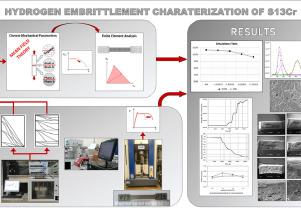Acta Materialia ( IF 8.3 ) Pub Date : 2021-01-10 , DOI: 10.1016/j.actamat.2020.116614 Debora Lima Molter , Mario Augusto Lopes de Castro , Dilson Silva dos Santos

|
This paper outlines experimental procedures and numerical analyses to investigate hydrogen embrittlement (HE) of S13Cr supermartensitic stainless steel (SMSS) subjected to various cathodic potentials. The hydrogen diffusion behavior was investigated using two electrochemical permeation techniques, namely, the double potentiostatic method (DPM) and the step method (SM), along with thermal desorption spectroscopy (TDS) tests. The apparent hydrogen diffusion coefficients varied from 1.4 × 10−13 to 4.7 × 10−12 m2/s, and TDS revealed the existence of deep traps, such as interfaces around precipitates and between retained austenite and ferritic matrix. The effects of HE in terms of a reduction in ductility were analyzed through tensile tests and fractographic analysis. A maximum reduction in elongation of approximately 14% was measured, and a majority of brittle fracture along the entire net section was observed in test samples pre-charged under -1.5 V/SCE and -1.7 V/SCE. A computational simulation was performed using the finite element method to predict the loss of ductility using the obtained experimental data. The computational model used a fracture-controlled method under static structural conditions, which links the reduction in elongation of the tensile specimens to the decrease in critical fracture energies, which, in turn, were calculated through a new mean field approach that used thermodynamic excess variables. The observations presented here suggest that S13Cr has good resistance to HE and that the computational model is reliable because only slight deviations in the magnitude (5%) were observed between the experimental and numerical results.
中文翻译:

氢在S13Cr超马氏体不锈钢界面分离中的作用
本文概述了实验程序和数值分析,以研究在各种阴极电势下S13Cr超马氏体不锈钢(SMSS)的氢脆(HE)。使用两种电化学渗透技术,即双恒电位法(DPM)和阶梯法(SM)以及热脱附光谱法(TDS)测试,研究了氢的扩散行为。表观氢扩散系数从1.4×10 -13到4.7×10 -12 m 2/ s,TDS显示存在深陷阱,例如沉淀物周围以及残留奥氏体和铁素体基体之间的界面。通过拉伸试验和分形分析分析了HE在延展性降低方面的效果。在-1.5 V / SCE和-1.7 V / SCE下预充电的测试样品中,测得的最大伸长率降低幅度约为14%,并且在整个净截面上观察到大部分脆性断裂。使用有限元方法进行了计算仿真,以使用获得的实验数据预测延展性的损失。该计算模型在静态结构条件下使用了一种裂缝控制方法,该方法将拉伸试样的伸长率降低与临界断裂能的降低联系起来,从而降低了断裂能。通过使用热力学过量变量的新平均场方法进行计算。这里提出的观察结果表明,S13Cr具有良好的抗HE能力,并且计算模型是可靠的,因为在实验结果和数值结果之间仅观察到幅度的微小偏差(5%)。











































 京公网安备 11010802027423号
京公网安备 11010802027423号